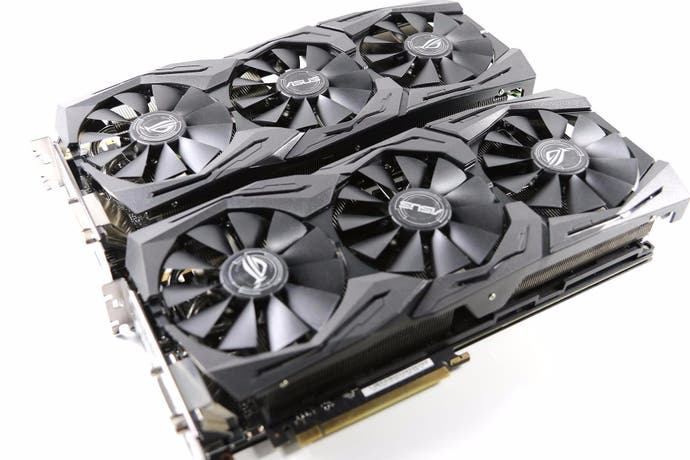Asus ROG Strix GTX 1080 Ti OC review: top-tier SLI tested
This GPU is incredibly fast, but how much faster are two of them?
4K displays are becoming mainstream now, prices are tumbling and graphics rendering technology is finally able to take advantage of these new screens, whether it's through checkerboarding or other upscaling, as seen on PS4 Pro, or else through sheer brute force in the PC space. Nvidia's GTX 1080 Ti still commands a price premium, but it's the most affordable GPU we've seen yet that powers PC gaming to native 4K at 60fps without too much in the way of visual compromises. And this led us to wonder: what would happen if two of them were paired in SLI?
Asus came through with two of its ROG Strix GTX 1080 Tis, an altogether different beast to the Founders Edition we've already reviewed. Whereas the reference design opts for the standard 'blower'-style configuration (albeit with a vapour chamber heatsink and improved cooling), the Asus model goes for traditional axial fans - three of them, no less - mounted atop a much larger heat sink than the standard design, with a 40 per cent increase in area. Asus reckons that their design is 30 per cent cooler than the Founders Edition and 3x quieter. On both counts, we would tend to agree. It's whisper quiet in operation and can maintain temperatures in the 70-75 Celsius range under load.
Of course, the trade-off with this type of design is that hot air is pumped into your chassis, as opposed to being pushed out of the rear of the PC, but Asus has a rather cunning solution to this in the form of its FanConnect2 technology, which allows you to connect your chassis fans directly to the graphics card. Put simply - if your GPU is pushing more heat into your case, it can directly control your case fans to increase velocity and push the hot air out.
On top of that, there's a factory overclock in place which adds a creditable 101MHz to the core, though the G5X memory only sees a meagre 100MHz OC - though pushing this upwards to its limits is child's play. Asus reckons you'll see around a five to seven per cent uptick in gaming performance here, but suffice to say that this card is capable of more. Its advertised max boost clock is 1708MHz, but real life performance is in the 1910-1960MHz range and there's a sliver of core overclocking headroom left over - but similar to the ROG Strix GTX 1070 and 1080, don't go in thinking there's bags of extra performance left in the tank - your best overclocking vector comes from boosting memory bandwidth.
Of course, as impressive as the package is, there's no such thing as a free lunch, and the ROG Strix edition of the GTX 1080 Ti adds around £80/$80 to the base £700/$700 of the reference model - but the price premium is offering significantly improved acoustics, almost all the GP102 core's theoretical air-cooled performance plus there are bonus goodies too in the form of Asus's Aura RGB lighting. In a world where custom edition cards can often add hundreds of pounds to a graphics card's base price, the added cost certainly isn't outlandishly high.
Buy the Nvidia GeForce GTX 1080 Ti from Amazon with free shipping.
But it's all about the performance, right? We've centred on 4K frame-rates for this review but you can check out our main GeForce GTX 1080 Ti review for a good idea on how the card scales on lower resolutions. To be honest, any 1080 Ti is wasted running at 1080p, while the straight GTX 1080 is the consummate 1440p card right now. The GTX 1080 Ti is best utilised at higher resolutions, be it ultra-wide 1440p or better yet, 4K.
However, 4K testing against the Founders Edition version of the card reveals something curious - we do get additional performance from the ROG Strix edition in the region of five per cent, but only in some titles. Others seem to perform identically to the reference card. We monitored core frequencies while benchmarking and can confirm that extra speed was delivered - we can only assume that either the Founders' boost clock can be more aggressive than we thought, or more likely, memory bandwidth is the limiting factor at such a high resolution.
Comparing the Asus card to the Founders Edition GTX 1080 (the non Ti version), we see improvements in performance ranging from 30 to 39 per cent, which is impressive, while the gulf in frame-rates increases to 65 to 80 per cent improvement when stacked up against the GTX 1070. Let's not forget that the 1070 represents equivalent performance to the best of the best from Nvidia's last-gen architecture - the Titan X Maxwell. Comparing a factory OC card to reference designs will boost the differentials of course, but the fact is that Pascal finally offers the performance we need to run effectively at ultra HD resolution.
We've also included SLI data in the table below. We won't dwell on this too much here as we have more illuminating metrics further on, but the bottom line is that factoring out the disappointing Ashes of the Singularity result, generally we're seeing performance increase by 42 per cent to 83 per cent depending on the title. The boost is palpable in most supported titles, but it's still disappointing when key games like Just Cause 3, Forza Horizon 3 and Call of Duty Infinite Warfare do not support SLI at all, effectively meaning that your second £700-£780 GPU is sitting there doing nothing.
| 3840x2160 (4K) | Asus GTX 1080 Ti SLI | Asus GTX 1080 Ti | GTX 1080 Ti FE | GTX 1080 FE | GTX 1070 FE | R9 Fury X |
|---|---|---|---|---|---|---|
| Assassin's Creed Unity, Ultra High, FXAA | 83.1 | 45.5 | 45.4 | 33.0 | 25.9 | 23.2 |
| Ashes of the Singularity, Extreme, 0x MSAA, DX12 | 86.8 | 81.2 | 76.8 | 60.2 | 48.7 | 48.8 |
| Crysis 3, Very High, SMAA T2x | 85.3 | 53.9 | 53.3 | 40.3 | 31.9 | 32.1 |
| The Division, Ultra, SMAA | 78.4 | 54.9 | 52.3 | 40.3 | 32.1 | 33.3 |
| Far Cry Primal, Ultra, SMAA | 82.0 | 55.5 | 55.2 | 42.3 | 33.8 | 35.1 |
| Rise of the Tomb Raider, Very High, High Textures, SMAA, DX12 | 109.3 | 64.5 | 60.5 | 46.2 | 36.1 | 34.0 |
| The Witcher 3, Ultra, Post AA, No HairWorks | 92.9 | 64.6 | 64.1 | 47.6 | 37.4 | 37.6 |
In our second set of metrics, we draw in SLI data from Asus ROG Strix GTX 1080 and GTX 1070 SLI configurations, sourced for our previous review. Driver optimisations and game improvements mean that only four of the games tested are comparable to our latest data. So for example, Nvidia's DX12 performance has increased significantly ruling out titles like Ashes of the Singularity, while The Division's multi-GPU microstutter we observed previously has now been resolved.
The four titles we have left are still illuminating though, especially when we compare GTX 1070 SLI performance to GTX 1080 Ti frame-rates. The vast variation in SLI scalability means that two 1070s can still soundly whip a single Ti in Assassin's Creed Unity and to a lesser extent in Far Cry Primal. Crysis 3 and The Witcher 3 hold up fairly well though, especially when overclocking on 1080 Ti is factored in. However, the fact that SLI effectiveness varies so much means that we'd definitely prefer the single card - especially when some games don't work with SLI at all. Two GTX 1070s also cost much the same as a single GTX 1080 Ti.
Two GTX 1080s in SLI soundly beats a single Ti as expected, but in terms of the ratio between performance and cost, the extra 40 per cent you'll pay for two GTX 1080s is only rarely reflected in the boost to frame-rates. Ideally, multi-GPU scalability needs to improve significantly to make either a GTX 1080 or 1070 SLI set-up pay off.
In terms of running two GTX 1080 Tis together, the experience you get is very simple to describe - you can run your games at maximum settings, or very close to it, and rest easy in the knowledge that a 60fps lock is virtually unshakeable. Across all of our benchmarks tests, only one small section of The Division's benchmark run - an area that blitzes the screen with volumetric smoke and GPU particles - caused any kind of noticeable deviation under 60fps.
| 3840x2160 (4K) | Asus GTX 1080 Ti | Asus GTX 1080 Ti OC | Asus GTX 1080 Ti SLI | Asus GTX 1080 SLI | Asus GTX 1070 SLI |
|---|---|---|---|---|---|
| Assassin's Creed Unity, Ultra High, FXAA | 45.5 | 48.0 | 83.1 | 67.5 | 56.1 |
| Crysis 3, Very High, SMAA T2x | 53.9 | 58.6 | 85.3 | 66.2 | 54.8 |
| Far Cry Primal, Ultra, SMAA | 55.5 | 60.4 | 82.0 | 79.6 | 64.2 |
| The Witcher 3, Ultra, Post AA, No HairWorks | 64.6 | 69.1 | 92.9 | 82.2 | 68.4 |
Our overclocking results came from adding 500MHz to the G5X modules, effectively taking us up to 12gbps of memory bandwidth, but the core wouldn't push past an additional 50MHz. This is enough to take the GP102 processor up to 2GHz, but moving beyond that caused instant instability. The result is 3-5fps of further performance, which is impressive at 4K resolution, and useful in stabilising gameplay at 60fps. All titles tested saw improvements here - something we didn't see with the Asus factory OC vs the Founders Edition - suggesting that memory bandwidth really is very helpful at a resolution as extreme as 4K. The lack of overclocking headroom on the GP102 core may seem disappointing, but actually, we prefer guaranteed stability and are happy knowing that the ROG Strix is offering up virtually everything the processor is capable of delivering when paired with an air cooler.
In terms of what a prospective GTX 1080 Ti SLI set-up gets you, there are potentially other avenues to explore beyond cranking up settings to the max on 4K screens - though it has to be said, it is somewhat liberating to enjoy full ultra HD gaming without having to worry much at all about holding 60fps.
We've already really pushed things to the max by attempting to run gameplay at 8K resolution (with variable results), but the notion of ramping up settings and playing on a triple-screen 1440p surround set-up could be valuable to some, while some of the success we saw running at what is essentially 7K resolution suggests that a GTX 1080 Ti SLI set-up could also do well running three 4K screens too (though VRAM could easily get maxed out on modern games).
It's also worth noting that the cooling design of the Asus ROG Strix isn't a great fit for most the Z170 and Z270 motherboards we've seen, which essentially puts the two cards side-by-side together. This results in one card blocking the heat output of the other, resulting in anything up to a 20 degrees Celsius differential between the two GPUs. In this scenario, the reference 'blower' design would be better, while the ROG Strix cards really need to be spaced apart. It's also worth remembering that Nvidia is recommending its new SLI bridge that facilitates higher bandwidth. Make sure you buy the bridge that matches the spacing of PCI Express slots on your motherboard.
Asus ROG Strix GTX 1080 Ti - the Digital Foundry verdict
The Nvidia GeForce GTX 1080 Ti is a monstrously good graphics card that finally sees GPU technology catch up with the extreme requirements needed to render PC games at very high settings at ultra HD resolution. Some settings tweakery is required to get the most demanding new games operating in the 60fps ballpark, but whether you buy a Founders Edition or a top-tier factory OC model like the Asus ROG Strix we've reviewed here, you will have a worthy companion for your 4K screen, while performance at ultra-wide 1440p is also exemplary. Below that, the law of diminishing returns kicks in as CPU and system memory bandwidth become more obvious as bottleneck points within your PC.
The Founders Edition is a good offering that goes a long way to resolving the thermal throttling issues encountered with prior GP102 and GP104-based Nvidia FE cards, so the advantages brought by aftermarket designs aren't quite so large this time around. The ROG Strix package essentially adds refinement in terms of its acoustics and temperature management, while the build quality of the chassis and the PCB are best-in-class. A lot of enthusiast PC gamers are also interested in producing a really good-looking piece of hardware too, and in this respect, the ROG Strix also delivers, with an attractive card and decent RGB lighting.
Our SLI tests show scalability in line with existing Pascal cards - but you should expect to see performance boosts scale with resolution, and we'd only really recommend pairing two GTX 1080 Tis for 4K and triple monitor surround set-ups. But it's the GTX 1070 SLI vs GTX 1080 Ti comparison we find the most intriguing in that performance results are often so close. Effectively what we're looking at there is today's top-tier GPU often delivering performance in the same ballpark as its last-gen counterpart running in SLI. And by extension, if Nvidia can continue to deliver these remarkable generational increases in performance, GTX 1080 Ti's next-gen successor should be staggeringly good.












